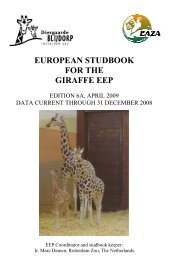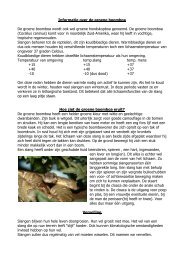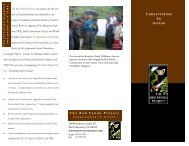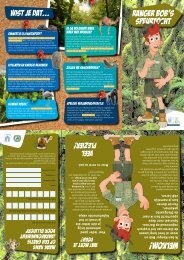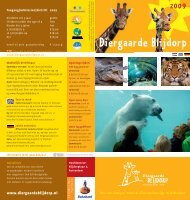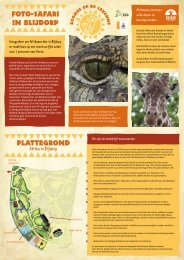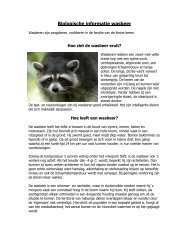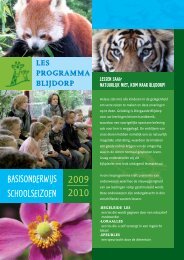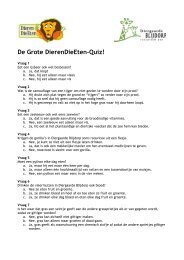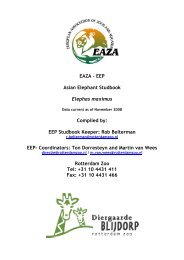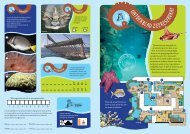You also want an ePaper? Increase the reach of your titles
YUMPU automatically turns print PDFs into web optimized ePapers that Google loves.
<strong>EEP</strong> STUDBOOK CROWNED PIGEONS INTRODUCTION<br />
2.1 Introduction<br />
Herewith we proudly present the fourth edition of the <strong>EEP</strong> Studbook for crowned <strong>pigeon</strong>s<br />
(Goura species). The <strong>EEP</strong> for crowned <strong>pigeon</strong>s started 1987 and in the past 12 years the<br />
<strong>number</strong> of crowned <strong>pigeon</strong>s registered in the program has increased substantially.<br />
Unfortunately this is not due to natural growth, but to legal imports and confiscation.<br />
In the wild crowned <strong>pigeon</strong>s are disappearing rapidly. The famous ornithologist Bruce<br />
Beehler, who conducted a lot of studies in New Guinea, wrote about crowned <strong>pigeon</strong>s:<br />
“The populations of crowned <strong>pigeon</strong>s are quickly eliminated by hunters from any forest<br />
within a days walk of some village. For Papua New Guinea, at least, most forest tracts lie<br />
within a day’s walk of some village; thus the two species of crowned <strong>pigeon</strong>s that inhabit<br />
Papua New Guinea are under threat.<br />
At this time it is critical that we initiate studies of the crowned <strong>pigeon</strong>s for at least two<br />
reasons. First, we need to learn something about this genus, one of the more remarkable<br />
evolutionary products of the long isolation of New Guinea’s tropical humid forest.<br />
Second, we must learn something about the Goura in the wild in order to develop a strategy<br />
for its long-term protection” (Beehler, 1991).<br />
Zoos and birdparks can contribute considerably to improve the knowledge about these<br />
magnificent <strong>pigeon</strong>s. This knowledge can be used by field workers to work more efficiently.<br />
On the contrary, field workers can, with the results of in situ studies, help institutions ex situ<br />
to improve the housing conditions in order to stimulate reproduction. In this way birdparks<br />
and zoos will be more better capable to build up a sustainable population which might be used<br />
(if necessary) to reintroduce birds into their natural habitat. Secondly, crowned <strong>pigeon</strong>s can be<br />
used as a ‘flagship-species’ to impress the visitors with the fauna of New Guinea, which is a<br />
tool to protect New Guinea’s flora and fauna.<br />
This fourth edition of the <strong>EEP</strong> Studbook contains both data from the wild as well as from<br />
European institutions. First of all the current status of the three species of crowned <strong>pigeon</strong>s is<br />
described. For each species attention is paid to the development of the <strong>EEP</strong>-population<br />
(births, deaths and transfers), the current <strong>EEP</strong>-population, founder representation and age<br />
distribution. The research chapter mainly focuses on research carried out in Papua New<br />
Guinea. Also a contribution to the discussion, whether crowned <strong>pigeon</strong>s are species or subspecies,<br />
is published. Recently a time budget analysis of crowned <strong>pigeon</strong>s kept under different<br />
housing conditions was carried out. This can be found in the research chapter, also with the<br />
information of longevity. The final chapter lists all publications of crowned <strong>pigeon</strong>s and a lot<br />
of articles on their natural habitat.<br />
We sincerely hope this Studbook will contribute to the welfare of crowned <strong>pigeon</strong>s, first in<br />
captivity and maybe later on also in the wild. We would like to thank all institutions and<br />
persons who contributed to this studbook, by submitting data or by giving comments on the<br />
third edition of the studbook or the draft edition of this studbook. Finally we would like to<br />
thank Rotterdam Zoo by giving financial support. We hope the birds will benefit from this.<br />
Ing. Joeke Nijboer (<strong>EEP</strong> Coordinator for crowned <strong>pigeon</strong>s) & Marc Damen<br />
16



